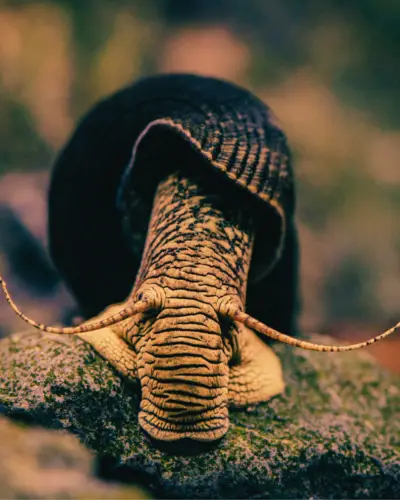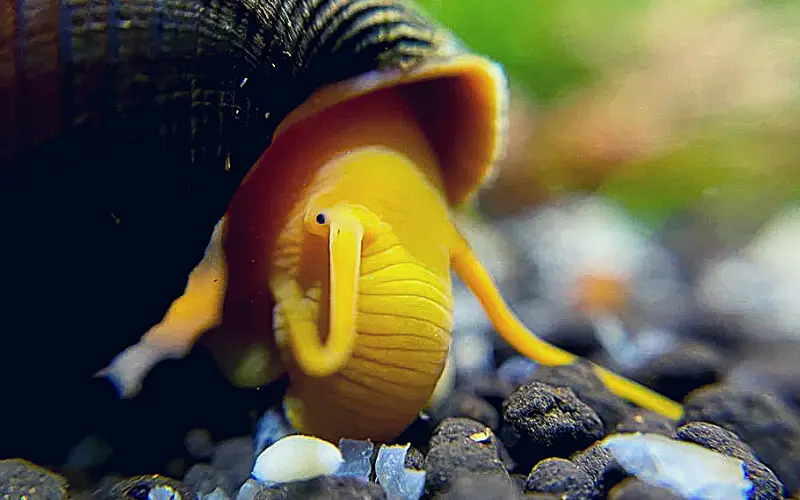Rabbit snails tylomelania are fascinating creatures that many aquarists love to keep in their tanks. These unique snails have specific water parameter requirements crucial for their health and well-being. This comprehensive guide will explore the ideal rabbit snail water parameters to thrive in your aquarium.
From pH levels to water hardness, temperature, and more, every aspect of water quality plays a significant role in ensuring the happiness and longevity of your elephant snails.
While these snails are relatively hardy, maintaining proper rabbit snails water parameter is essential for their overall health and reproductive success.

Whether you are a beginner looking to add rabbit snails to your tank or a seasoned enthusiast wanting to fine-tune your water conditions, this guide will provide you with the knowledge and tools needed to create the perfect environment for these captivating creatures.
Let’s dive in and discover all you need to know about the ideal rabbit snail water parameters.
Table of Contents
ToggleWhat Conditions Do Rabbit Snails Like?
Rabbit snails are a type of freshwater snail that is native to the Sulawesi Indonesia region. These unique snails can grow up to four inches in length and come in various colors, such as golden rabbit snails and black rabbit snails.
Regarding tank conditions, rabbit snails prefer a larger tank with plenty of plant matter and a sponge to feed on. They also require a diet rich in calcium, which can be provided through snail pellets or algae wafers.
It is essential to keep in mind that rabbit snails are peaceful creatures that should be kept with non-aggressive tank mates, such as nerite snails or trumpet snails.

When it comes to a care guide, rabbit snails also need stable water quality and regular water changes to thrive. They are sensitive to changes in temperature or water parameters, so it is vital to keep your snails in a well-maintained community tank.
It is also recommended to avoid using plant fertilizers or any chemicals that can harm the snails. Additionally, rabbit snails can’t tolerate high levels of copper in the water, so it is essential to test your water quality regularly.
If your rabbit snail is not moving or behaving unusually, it is vital to check for signs of illness or stress. This could indicate that the snail is not getting enough calcium in its diet or that there are issues with the water quality.
Another thing to remember is that rabbit snails are known to reproduce slowly, with females only laying a few eggs at a time. If you have a baby snail in your tank, give them plenty of hiding spots and food to help them grow.
The Ideal Rabbit Snail Water Parameters (for Maximum Rabbit Snail Lifespan)
Providing optimal water conditions is critical to maximizing your rabbit snail’s lifespan. Aim for:
- Temperature: 76-82°F (24-28°C) – Warmer water promotes activity and metabolism.
- pH: 7.5-8.0 – Alkaline conditions are ideal for shell health and growth.
- Hardness: 10-15 dKH – Moderately hard water ensures sufficient minerals for shell development.
- Cleanliness: Regular water changes and efficient filtration are crucial to maintain pristine water quality and prevent ammonia/nitrite buildup.
Some Different Types Of Rabbit Snails
Rabbit snails are interesting snail species that can be found in pet stores for aquarium enthusiasts. Several types of rabbit snails are available, such as white spotted rabbit snails and orange rabbit snails.
This genus of freshwater snails is known for their unique appearance and can grow to the size of a rabbit. Rabbit snails make great tank mates like mystery and assassin snails for other aquarium snails.
It is essential to keep rabbit snails in a planted tank to provide them with a balanced diet and prevent the buildup of ammonia and nitrite at the bottom of the tank.
Since these snails are herbivores, they enjoy grazing on aquarium plants and will help keep the tank clean. Providing a rabbit snail care guide is recommended to ensure their well-being. Additionally, elephant snails are known to be relatively peaceful creatures and will not harm other tank inhabitants.
When looking for snails to add to your aquarium, consider the benefits of adding rabbit snails to your collection. Rabbit snails can enhance your aquarium’s diversity and beauty while providing valuable ecosystem services.
Rabbit Snail Care Requirements
With their unique appearance and peaceful nature, rabbit snails are a delightful addition to any freshwater aquarium. Here’s a guide to providing optimal care and ensuring your snails thrive:
Tank Setup:
- Size: A minimum of 10 gallons is recommended, but larger is always better, especially for multiple snails or tank mates.
- Substrate: Opt for sand or fine gravel to prevent damage to their delicate bodies as they crawl.
- Decorations: Provide ample hiding spots like caves, driftwood, and dense vegetation.
- Plants: Live plants like Java Fern, Anubias, and Hornwort offer shelter and a supplementary food source.
- Water Parameters: Maintain a temperature of 72-82°F (22-28°C), pH of 7.0-8.0, and hardness of 8-12 dKH.
Diet:
- Algae: Rabbit snails are primarily algae eaters, so a mature tank with some algae growth is beneficial.
- Supplements: Supplement their diet with blanched vegetables (zucchini, spinach), algae wafers, and sinking pellets.
Care Tips:
- Calcium: Offer a calcium source like cuttlebone to promote healthy shell growth.
- Water Quality: Perform regular water changes (25-50% weekly) and ensure efficient filtration.
- Tank Mates: Choose peaceful fish or invertebrates that won’t harm the snails. Avoid aggressive species and snail-eaters.
- Copper Sensitivity: Do not use copper medications; rabbit snails are sensitive.
By following these care guidelines, you can ensure your rabbit snails live a long and healthy life, adding beauty and balance to your aquatic environment.
Rabbit Snails Best Tank Mates
Rabbit snails are best kept with other peaceful tank mates that won’t bother them. Good tank mates for rabbit snails include other slow-moving and non-aggressive snails like Mystery and pond snails.
Since rabbit snails can grow to the size of a rabbit, it’s vital to choose tank mates that won’t harm them. Mini rabbit snails, like chocolate and yellow, can also be good companions.
These snails are pretty active and enjoy feeding on algae and plant matter. It’s essential to properly care for them and provide the right tank environment, as snails are susceptible to changes. Remember that some tank fish may be aggressive and potentially harm or even kill the snails.
Snails can be found in many tanks, a popular choice for cleaning algae and debris. Keeping more than one snail species in a regular tank can help maintain a healthier ecosystem.
Since snails require alkaline water in the 8.2 range, monitoring and maintaining the rabbit snails water parameter is essential to keep them healthy. Rabbit snails usually reach their full size as adult snails within a few months.
Adding live aquarium plants can also provide snail hiding spots and additional food sources. When introducing new snails to a tank, it’s crucial to acclimate them slowly to prevent shock.
The Recommended Minimum Tank Size for Rabbit Snails (Minimal – Optimal)
While rabbit snails can technically survive in smaller tanks, providing ample space is crucial for their well-being and happiness. Here’s a breakdown:
- Minimum Tank Size: 10 Gallons – This is the absolute minimum for a single elephant snail. However, it limits their space for exploration and foraging.
- Recommended Tank Size: 20+ Gallons – This offers more room for the snail to move around, establish a territory, and exhibit natural behaviors.
- Optimal Tank Size: 30+ Gallons – A larger tank allows for a more diverse and enriching environment, especially if keeping multiple snails or other tank mates.
Remember, bigger is always better for providing a comfortable and stimulating habitat for your rabbit snails.
Tips for Rabbit Snail Breeding In Freshwater Aquariums
Rabbit snails are a unique addition to freshwater aquariums, known for their resemblance to rabbits with their long “rabbit ears” and the size of a rabbit snail. When breeding these snails, it is important to provide them with a suitable environment, such as a 20-gallon tank with plenty of hiding spots.
Additionally, keep in mind that chocolate rabbit snails are just one color variation of these creatures, so be prepared for many snails to come about. These snails use their elephant snail-like trunk to sift through substrate and feed on algae and decaying plants, making them a beneficial addition to your tank’s ecosystem.
Monitor the water parameters closely and separate aggressive or unhealthy snails since they can negatively affect breeding. Once mature, snails reach reproductive age and can produce offspring in a relatively short amount of time.
Commonly Asked Questions about Rabbit Snails Water Parameter (FAQs)
What are the best water parameters for snails?
Most snails thrive in slightly alkaline, moderately hard water. Aim for a pH of 7.0-8.0 and hardness between 8-12 dKH for optimal shell and overall health.
What is the best substrate for rabbit snails?
The best substrate for rabbit snails is fine sand or smooth gravel. This prevents damage to their delicate bodies as they move around the tank.
What is a good tankmate for a rabbit snail?
Peaceful fish like tetras, Rasboras, and Corydoras catfish make excellent tank mates for rabbit snails. Avoid aggressive or snail-eating species.
What size tank does a rabbit snail need?
A single rabbit snail needs a minimum tank size of 10 gallons. However, 20 gallons or more is recommended for optimal space and well-being.
Can a rabbit snail live with a betta?
While possible, keeping rabbit snails with betta fish is risky. Bettas can be unpredictable and may nip at the snails’ antennae or bodies. Close monitoring is crucial.
What temperature do rabbit snails like?
Rabbit snails prefer warmer water temperatures between 72-82°F (22-28°C). This range promotes these tropical snails’ activity, metabolism, and overall well-being.
What is the natural habitat of the rabbit snail?
Rabbit snails come from Sulawesi lakes and rivers in Indonesia. Warm temperatures and slightly alkaline water characterize these habitats.
Conclusion
The Hidden Gems of the Aquarium: Unmasking the Rabbit Snail: Caring for rabbit snails goes beyond providing food and shelter. It’s about understanding their unique needs and creating an environment where they can flourish. From their algae-grazing habits to their peaceful co-existence with other tank mates, these snails offer a fascinating glimpse into the intricate balance of aquatic life. So, delve deeper into the world of rabbit snails. Learn about their ideal rabbit snail water parameters, their dietary preferences, and their role in maintaining a healthy ecosystem. By understanding their specific requirements, you unlock the key to keeping them alive and thriving in your aquarium.
You might also like
- White Spotted Rabbit Snail 101: (A Comprehensive Care Guide)
- How Many Rabbit Snails Per Gallon: 2 EASY Steps for Success!
- What to Feed Rabbit Snails: (7 POWER Foods They LOVE!)
- Rabbit Snail Temperature Range 101: A Comprehensive Care Guide
- Assassin Snail Temperature 101: Clea Helena (Expert Advice)
- Do Rabbit Snails Eat Other Snails: (1 Shocking Truth!)
- Do Elephant Snails Hibernate: (Secret Winter Survival Trick!)





